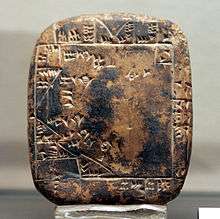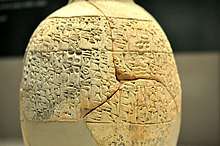Umma
 Plan of a real estate of the city of Umma, with indications of the surfaces of the parts. Third Dynasty of Ur, Le Louvre. | |
 Shown within Iraq | |
| Location | Dhi Qar Province, Iraq |
|---|---|
| Region | Mesopotamia |
| Coordinates | 31°37′16.93″N 45°56′0.26″E / 31.6213694°N 45.9334056°ECoordinates: 31°37′16.93″N 45°56′0.26″E / 31.6213694°N 45.9334056°E |
| Type | Settlement |
Part of a series on the |
|---|
| History of Iraq |
| Ancient Mesopotamia |
| Classical antiquity |
| Middle Ages |
| Early modern period |
| Modern Iraq |
|
|
Umma (Sumerian: 𒄑𒆵𒆠 ummaKI;[1] modern Umm al-Aqarib, Dhi Qar Province in Iraq) was an ancient city in Sumer. There is some scholarly debate about the Sumerian and Akkadian names for this site.[2] Traditionally, Umma was identified with Tell Jokha. More recently it has been suggested that it was located at Umm al-Aqarib, less than 7 km to its northwest or was even the name of both cities.[3][4]
History

In the early Sumerian text Inanna's descent to the netherworld, Inanna dissuades demons from the netherworld from taking Shara, patron of Umma, who was living in squalor. They eventually take Dumuzid king of Uruk instead, who lived in palatial opulence.[5]
Best known for its long frontier conflict with Lagash,[6] the city reached its zenith c. 2275 BC, under the rule of Lugal-Zage-Si, who also controlled Ur and Uruk. Under the Ur III dynasty, Umma became an important provincial center. Over 30,000 cuneiform tablets recovered from the site are administrative and economic texts from that time. They permit an excellent insight into provincial affairs in Umma.[7] The Umma calendar of Shulgi (c. 21st century BC) is the immediate predecessor of the later Babylonian calendar, and indirectly of the post-exilic Hebrew calendar. Umma appears to have been abandoned after the Middle Bronze Age.[8]
Archaeology
The site of Tell Jokha was visited by William Loftus in 1854 and John Punnett Peters of the University of Pennsylvania in 1885.[9][10] In the early 1900s, many illegally excavated Umma tablets from the Third Dynasty of Ur began to appear on the antiquities market.[11] In the late 1990s, some salvage excavation related to a roadway project was conducted at Tell Jokha by Iraqi archaeologists.[12] Since then, Tell Jokha has been identified as Umma's dependency Gisha (or Kissa), while the site of Umma itself has been located about 6.5 km to the southeast, at Umm al-Aqarib. At Umm al-Aqarib, archaeologists uncovered levels dating as early as the Early Dynastic Period (c. 2900–2300 BC), including several monumental buildings, one of them variously identified as a temple or palace.[13][14]
In 2017, the Slovak Archaeological and Historical Institute began excavations at Tell Jokha. [15]
Looting
During the 2003 invasion of Iraq, after Coalition bombing began, looters descended upon the site which is now pockmarked with hundreds of ditches and pits. The prospects for future official excavation and research were seriously compromised in the process.[16] Looting trenches were dug over an area the size of 3,000 soccer fields in various sites within Iraq, according to a 2007 report in The Independent.[17]
In 2011, Global Heritage Network, which monitors threats to cultural heritage sites in developing nations, released aerial images comparing Umma in 2003 and 2010, showing a landscape devastated by looters' trenches during that time—approximately 1.12 square km in total.[18] Additional images relevant to the situation at Umm al-Aqarib are included in Tucker's article on the destruction of Iraq's archaeological heritage.[19]
Notes
- ↑ "ORACC – Umma".
- ↑ W. G. Lambert, "The Names of Umma", Journal of Near Eastern Studies, vol. 49, no. 1, 1990, pp. 75–80.
- ↑ Vitali Bartash, "On the Sumerian City UB-meki, the Alleged “Umma”, Cuneiform Digital Library Bulletin 2015:2, Cuneiform Digital Library Initiative, November 2015, ISSN 1540-8760
- ↑ Trevor Bryce, The Routledge Handbook of The Peoples and Places of Ancient Western Asia: The Near East from the Early Bronze Age to the fall of the Persian Empire, Routledge, 2009, pp. 738–739.
- ↑ Inanna's descent to the netherworld - ETCSL
- ↑ Jerrold S. Cooper, History from Ancient Inscriptions: The Lagash-Umma Border Conflict, Undena, 1983, ISBN 0-89003-059-6
- ↑ P. A. Parr, "A Letter of Ur-Lisi: Governor of Umma", Journal of Cuneiform Studies, vol. 24, no. 4, pp. 135–136, 1972
- ↑ Trevor Bryce, The Routledge Handbook of The Peoples and Places of Ancient Western Asia: The Near East from the Early Bronze Age to the fall of the Persian Empire, Routledge, 2009, 738-739.
- ↑ William K. Loftus, Travels and Researches in Chaldaea and Susiana, Travels and Researches in Chaldaea and Susiana: With an Account of Excavations at Warka, the "Erech" of Nimrod, and Shush, "Shushan the Palace" of Esther, in 1849-52, Robert Carter & Brothers, 1857
- ↑ John P. Peters, Nippur; Or, Explorations and Adventures on the Euphrates: The Narrative of the University of Pennsylvania Expedition to Babylonia in the Years 1888–1890, University of Pennsylvania Babylonian Expedition, Putnam, 1897
- ↑ Georges Contenau, Contribution a l'Histoire Economique d'Umma, Librairie Champion, 1915
- ↑ Salah Salman Rumaidh, Excavations in Chokha: An Early Dynastic Settlement, Nabu, 2000, ISBN 978-1-897750-08-7
- ↑ Trevor Bryce, The Routledge Handbook of The Peoples and Places of Ancient Western Asia: The Near East from the Early Bronze Age to the fall of the Persian Empire, Routledge, 2009, 738–739.
- ↑ Haider Oraibi Almamori, The Early Dynastic Monumental Buildings At Umm Al-Aqarib, Iraq, vol. 76, pp. 149-187, December 2014
- ↑ Drahoslav Hulínek and Tibor Lieskovský, Report Archaeological project SAHI - Tell Jokha, 2016, Slovak Archaeological and Historical Institute, 2016
- ↑ Guardian article on Umma looting
- ↑ Marie Woolf (15 April 2007). "Desecration of the Cradle of Civilisation". The Independent.
- ↑ Satellite Imagery Briefing: Monitoring Endangered Cultural Heritage
- ↑ Diane Tucker (21 September 2009). "Brutal Destruction of Iraq's Archaeological Sites Continues". uruknet.info.
See also
References
- B. Alster, Geštinanna as Singer and the Chorus of Uruk and Zabalam: UET 6/1 22, JCS, vol. 37, pp. 219–28, 1985
- Tonia M. Sharlach, Provincial taxation and the Ur III State, Brill, 2003, ISBN 90-04-13581-2
- Trevor Bryce, The Routledge Handbook of The Peoples and Places of Ancient Western Asia: The Near East from the Early Bronze Age to the fall of the Persian Empire, Routledge, 2009
- B. R. Foster, Umma in the Sargonic Period, Memoirs of the Connecticut Academy of Arts and Sciences, vol. 20, Hamden, 1982
- Georges Contenau, Umma sous la Dynastie d'Ur, Librarie Paul Geuthner, 1916
- Jacob L. Dahl, The Ruling Family of Ur III Umma: A Prosopographical Analysis of an Elite Family in Southern Iraq 4000 Years ago, Nederlands Instituut voor het Nabije Oosten/Netherlands Institute for the Near East (NINO), 2007, ISBN 90-6258-319-9
- Shin T. Kang, Sumerian economic texts from the Umma archive, University of Illinois Press, 1973, ISBN 0-252-00425-6
- Diana Tucker, "Brutal Destruction of Iraq's Archaeological Sites Continues", online article from September 21, 2009 posted on www.uruknet.info, http://www.uruknet.info/?p=58169